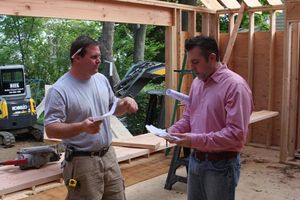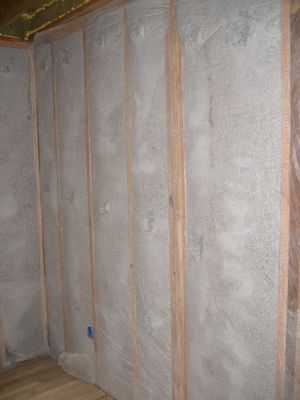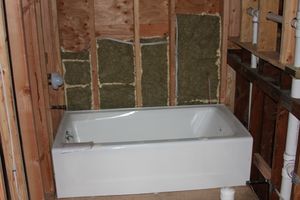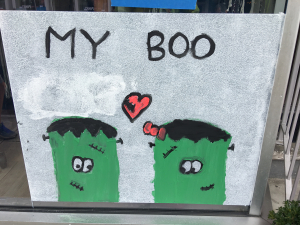The Whole House Envelope: Green Insulation at the MyRye.com House
(PHOTO: Ron Pascione of BHK Builders and Chris Puleo of Green Star Energy talk high R-values.)
When we sat down and decided the MyRye.com house would go green, insulation was at the top of our list. Before solar, geothermal, windows and Energy Star appliances, insulation will pay us back fast – providing a "tight" house designed to keep us cool in summer and warm in winter.
Our "Queen of Green" Judy Martin of Green Home Consulting recommended Green Star Energy Solutions and its animated Westchester Director Chris Puleo. Green Star has been called out to the site by MyRye.com House builder BHK a few times for preliminary work – to caulk and seal various plates and to place roxul insulation behind bathtub installations (many times tubs are installed before the insulation company shows leaving an energy black hole right next to your rubber ducky).
This week BHK is calling in the big guns – Green Star will start its whole house insulation work with cellulose. MyRye.com spoke with Green Star's Chris Puleo to tell us what he's going to do to protect our family and our wallet from the winter cold and summer heat.
Your Name: Chris Puleo – Director of Westchester Operations – Green Star Energy Solutions
What are you doing at the MyRye.com House?
Providing a continuous thermal boundary, high performance, insulation envelope using the most earth friendly products available.
Why is Green Fiber all borate cellulose insulation a green building choice? What traditional building product is replaced and how much more efficient is your product?
Boric acid treated cellulose is high performance, low embodied energy insulation that can provide an air barrier. It is a class A fire material that will not burn. It will stave off insects and rodents. It has a lifetime guaranty not to support microbial growth (no mold, no mildew) It is so hygroscopic it will keep moisture away from unprotected wooden building components. It is made in Albany from post consumer recycled paper and has an R-value of 3.8 per inch.
(PHOTO: Cellulose insulation from another green house. The white netting is attached to the framing and cellulose is "dense packed" inside.)
Typical fiberglass is low performance, high embodied energy insulation that allows air and airborne humidity to move through it. It has a flame spread rate of 25 and a smoke rate of 50 and will melt. Insects have no problem moving through it or living in it. Rodents love it as a nesting material. It will support microbial growth. It is hydrophobic and will force moisture to surrounding unprotected building components. It is a petroleum based product often shipped from half way around the world and has a typical installed R-value of less than 3 per inch.
What about spray foam insulation—that is often mentioned as another “green” choice. How does this compare to cellulose?
Spray foam is a high embodied energy, high performance insulation that can provide an air barrier. Minimal amounts of spray foam are required to provide a properly air sealed house but it should be used with consideration to all other building factors like moisture migration, vapor barriers, etc…
Is there typically a premium on the upfront installation cost as compared to the traditional building product? And what is the typical time horizon for the homeowner’s return on investment?
A high performance envelope should cost approx 20% more in upfront costs but will provide approx 40% savings in energy use and allow the down sizing of major mechanical appliances while improving comfort and indoor air quality.
(PHOTO: Early on Green Star was called in by BHK Builders to place roxul insulation in certain bathroom walls before tub installation. Rubber Ducky will be comfortable.)
Explain the idea of a “whole house envelope”.
Modern building science is based on addressing the home as a system, each trade and practice affects the next. Defining the thermal boundary and aligning it with the pressure boundary then installing a high performance shell is the best practice (research at www.bpi.org or www.buildingscience.com)
Have you completed other green insulation jobs in Rye City?
We have completed work on over 40 homes in Rye, from 1 bedroom apartments to 10,000 sq. ft. gut renovations and everything in between.
What web resources do you recommend for homeowners interested in green building?
www.goreenstar.com www.greenhomeswestchester.com www.bpi.org www.buildingscience.com www.getenergysmart.org
Documents and resources from Green Star:
Consumer Reports article on how to save money
NYSERDA Home Performance with Energy Star
What made you decide to enter the green building field?
A sense of responsibility combined with influential contacts in the building trades.
Tell us your contact information:
Your web site: www.gogreenstar.com
Your phone: 646-299-4529
Your email address: chrispuleo@gogreenstar.com
Thanks Chris!








